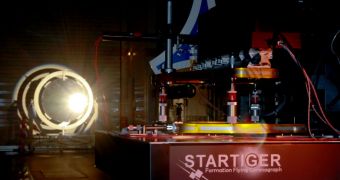In September 2009, a group of prominent scientists was convened by the European Space Agency (ESA) at one of its research facilities with a single objective – produce a space-based setup that would allow for the continuous analysis of a portion of the Sun hiding in plain sight. The results of the investigation were announced yesterday, April 27, as the six-month-long research project was officially closed down on time, at the agency's European Space Research and Technology Center (ESTEC), in the Netherlands.
The StarTiger project is one of ESA's latest endeavors, and it was developed at the Laboratoire Astrophysique d’Marseille (LAM), where the science team was convened. Inside a clean room at the facility, the researchers constructed a scale-model prototype of the new mission, whose main goal is to create a perpetual eclipse in space. Usually, the edges of the Sun are only visible from Earth during a full eclipse by the Moon, but the astronomical event happens rather rare. What ESA wanted to achieve is the capability to conduct eclipse study around the clock.
The solution its research team proposed was constructing a double-satellite system. The instruments would fly in a close, tight formation, where the one in front would cast a perennial shadow on the one in the back. This approach raises monumental engineering problems, given that both spacecraft would be flying at high speeds through space. The navigation and control systems are the most difficult aspects to set up, but the endeavor is not impossible, scientists say.
“ESA’s StarTiger is a new R&D approach, one that has paid off handsomely here. This integrated ‘breadboard’ demonstrator has been completed in just six months, including all necessary subsystems, mathematical models and software, to not only validate the external coronagraph concept but assess its performance in practical terms,” explained at yesterday's ceremony the supervisor of the initiative, expert Peter de Maagt.
“The main objective was achieved together with several secondary objectives. The idea was to perform relative positioning between the two satellites and absolute positioning with respect to the Sun. Working face-to-face in the same room was our key to success, considering the schedule we faced. We combined our various competences to solve the many problems that arose along the way,” added LAM team leader Sebastien Vives. He managed the main research group of seven experts, who were supported by 20 other investigators.

 14 DAY TRIAL //
14 DAY TRIAL //